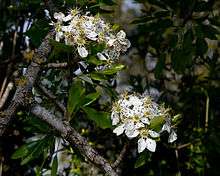Pyrus syriaca
Pyrus syriaca, the Syrian pear, is a deciduous tree of the Rose family. It is the only pear species which grows in the wild in Lebanon[1], Turkey, Syria and Israel.
| Syrian pear | |
|---|---|
 | |
| Scientific classification | |
| Kingdom: | Plantae |
| Clade: | Tracheophytes |
| Clade: | Angiosperms |
| Clade: | Eudicots |
| Clade: | Rosids |
| Order: | Rosales |
| Family: | Rosaceae |
| Genus: | Pyrus |
| Species: | P. syriaca |
| Binomial name | |
| Pyrus syriaca | |
The Syrian pear is a protected plant in Israel. It grows in unsalted ground, usually in Mediterranean scrub, in west Syria, in the Galilee and the Golan.
In the months of March and April, the tree blossoms with white flowers. The fruit ripen in the autumn in the months of September and October. The fruit is edible, though not as good as the European Pear, mostly because of hard, stone like objects found in the skin. The ripe fruit falls to the ground and when it starts to rot, the smell attracts wild boars. The boars eat the fruit and distribute the seeds.
References
- Tohmé, Georges and Henriette (2014). Illustrated Flora of Lebanon. Lebanon: National Council for Scientific Research, Lebanon. p. 531. ISBN 9789953028903.
External links
- Pyrus syriaca Israel native plants


This article is issued from Wikipedia. The text is licensed under Creative Commons - Attribution - Sharealike. Additional terms may apply for the media files.